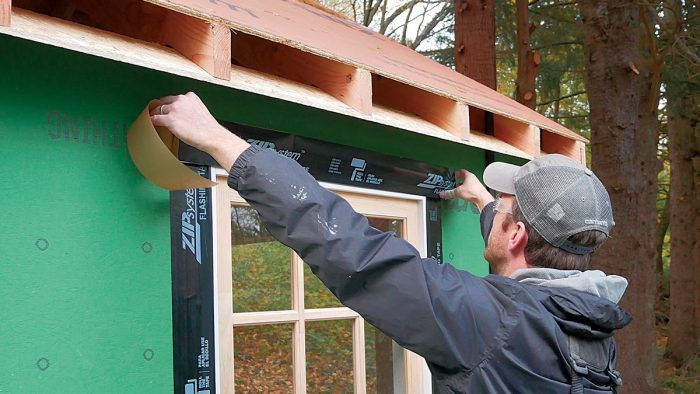Caulking and Caring, Taping and Trying
One builder's solution for making sure waterproofing and air-sealing are done right is to have a dedicated crew member oversee quality control.

Synopsis: Controlling water and air is imperative while building, but most of our existing housing stock is deficient. Builder Travis Brungardt proposes a solution: Select and train an “air-sealing technician” and a “water-control specialist.” The goal when filling these positions is not to hire an expert, but to train a motivated, detail-oriented worker to be responsible for water management and air-sealing, checking tape joints and sealant and eliminating all gaps and holes and thus controlling one of the most important aspects of construction.
It’s no secret that much of our existing housing stock is deficient when it comes to controlling water and air. That’s not to blame our predecessors—timing is everything, and old houses were designed with the information and technology available at the time.
This might lead you to logically conclude that the problem with the new houses we’re building is one of similar origins—that we somehow can’t do any better with the stuff we have to work with, or that we don’t know the next steps to improve performance. That’s simply not the case. Not only do we have all the information, technology, and material we need to make new houses better, but we can do the same to old houses, helping the performance of every project we touch reach the very highest measurable levels. So, if it’s not materials or technology, what’s the problem? If you ask me, the greatest deficiency in the performance of most homes being built or remodeled today is a lack of precisely placed effort. The solution to our underperforming builds lies not with products, but with people.
The one thing that every material in any building assembly has in common is its primary weakness: us. The installers make or break every detail they touch, and the diligence and understanding of these individuals will dictate the performance of the building, the daily comfort of its occupants, and, since failure often means replacement, its long-term durability.
Since we are the biggest weakness, this is what I propose: In addition to all the typical crew members on a project, choose an additional person to be fully responsible, from start to finish, for all of the air-sealing and water-management quality control.
The ideal candidate
If your operation is large enough to support another helper, laborer, or apprentice, you may choose to bring in someone with the ideal qualifications for this position. These “qualifications” are not what you might imagine; this person doesn’t need to be an established expert at controlling air and water. The most important thing is diligence when it comes to quality control. Perhaps your crew already has someone like this—someone who’s capable of slowing down a bit, who’s attentive and thorough, and who is thoughtful about the work rather than simply going through the motions.
My suggestion is to take a less experienced member of your crew, perhaps your lowest-paid helper, and give that person a modest promotion from laborer or apprentice to “air-sealing technician” or “water-control specialist.” The purview of the air-sealing technician is caulking and caring, while that of the water-control specialist is taping and trying. Maybe one person does both jobs, or you assign the tasks to two different workers. Either way, foster confidence and responsibility in an entry-level worker by taking time to explain the “why” of water and air control.
Of course, even motivated workers need guidance. It will require an investment of time—your most precious resource—regardless of who you select for this role. You can’t just say, “This point in the roof will need a kickout flashing,” and expect that to sink in. You have to walk through several jobs together, looking at potential failures and connecting the solutions back to the problems. Only with hands-on instruction will you effectively move someone from unengaged installer to thinking problem-solver—a person who understands fluid management from concept through execution.
Stress that speed is not the goal with this work. Being an air-sealing technician or water-control specialist is akin to being a trim carpenter, in which pace can only increase with experience. Instead of speed, enforce the idea that absolutely nothing can be missed. Drive home the point that every bead of sealant must be continuous and every tape joint must be rolled completely, and that these are the only priorities for this specialist. One hundred percent isn’t just the goal, it’s the demand—no compromise or “close enough” will suffice. None of us would get on a boat that’s 95% sealed to water, because that sucker is gonna sink. The specialist needs to view the details of the work as a vital endeavor because, for both the durability of the building and the health of the occupants, it could mean life or death.
The tasks of verifying water-management details and air-barrier continuity can be easily broken down into lines on the plan, but to chase these lines off the plan and into the field requires a meticulous, attentive person with the capacity to understand not just construction, but culture. So, in addition to the hands-on teaching, be sure to also discuss the philosophical side of building. If you have the capacity to invest in the idea of your product as a home—a place where a family will raise children, celebrate holidays, and seek refuge—then you can begin to care about the second, third, and fourth owners of that home. This mindset will make it easier to care about the tasks that make or break that goal.
We have to reimagine our roles not just as people who shape products and materials into dwellings to suit our customers’ whims, but as conservators who use resources diligently to create homes that last generations and preserve the planet’s health. It’s a long-term cultural initiative that may elicit a snicker or two from those who aren’t ready to play the long game, but if they’re receptive to the concept of critical continuity, they can dictate the fate of building performance—and, to some extent, the health, comfort, and financial security of the occupants that reside in the building.
Daily work
The water-control specialist has to be trained on the principals of bulk-water management as well as the specific system of flashings and water-resistive barrier (WRB) materials you favor for your projects. The approach to keeping water out of the building, or allowing a path for escape, must be 100% effective at every potential point of entry. Being meticulous in verifying the water-control layer from the ridge down to the footing is not as complex as it is time-consuming.
Instead of taking the small sample-size method in which you might check your framers’ install on one or two windows to confirm the proper lapping of flashing tapes to WRB, make your water-control specialist responsible for checking every single one and correcting any deficiencies. This will take more time than most carpenters are used to spending rolling, smoothing, or pulling at the edges of the tape to ensure adhesion. A simple kit of WRB scraps, compatible sealants, tapes, and perhaps some standard flashings will likely develop over time and can pay dividends in efficiency.
For the air-control technician, critical continuity is the essence of the job, since any point at which you interrupt the bead of sealant or fail to tape the air barrier will have a ripple effect. Like a pinhole in a balloon, these errors may seem small and insignificant, but can lead to the catastrophic failure of the whole.
When air-sealing is done well, a home is more efficient at keeping its occupants comfortable. To achieve this, we need only to understand basic fluid dynamics and be willing to make the effort to keep the barrier continuous. Sure, it helps to know that the stack effect dictates that our risk is amplified at the bottom-plate connection to the foundation as well as at the top plate transition to soffit or ceiling. That said, even if you failed physics, you can still learn to run a continuous bead of sealant or apply a smooth layer of tape to a transition. It really comes down to your air-sealing technician having the desire to eliminate all gaps and holes.
Yes, it’s that simple. Your air barrier must be planned before the build begins, your materials must be compatible with that plan, and the air-sealing technician must remain ever vigilant in keeping the tape application smooth or beads of caulking continuous regardless of what corner must be turned or which plane change is encountered. The technician must keep a watchful eye on all subcontractors and where they drill holes in the building envelope. It all boils down to someone taking ownership and approaching the work with the 100-year vision of durability and performance.
This may seem like an oversimplification of our complicated jobs as builders. Suggesting that you try really hard and strive for success isn’t particularly useful advice. You must go much deeper than telling your crew to “do it right” as you hop in the truck and head to the next job. Don’t sink the ship; don’t pop the balloon—however you want to visualize the task at hand, make it happen. The stakes are high, but we know how to manage them.
Travis Brungardt is part-owner of Catalyst Construction, a building company in Prairie Village, Kan.
Photo: Rodney Diaz
From Fine Homebuilding #293
More about managing air and water in houses:
What Makes the ‘Best’ Air Barrier?






















